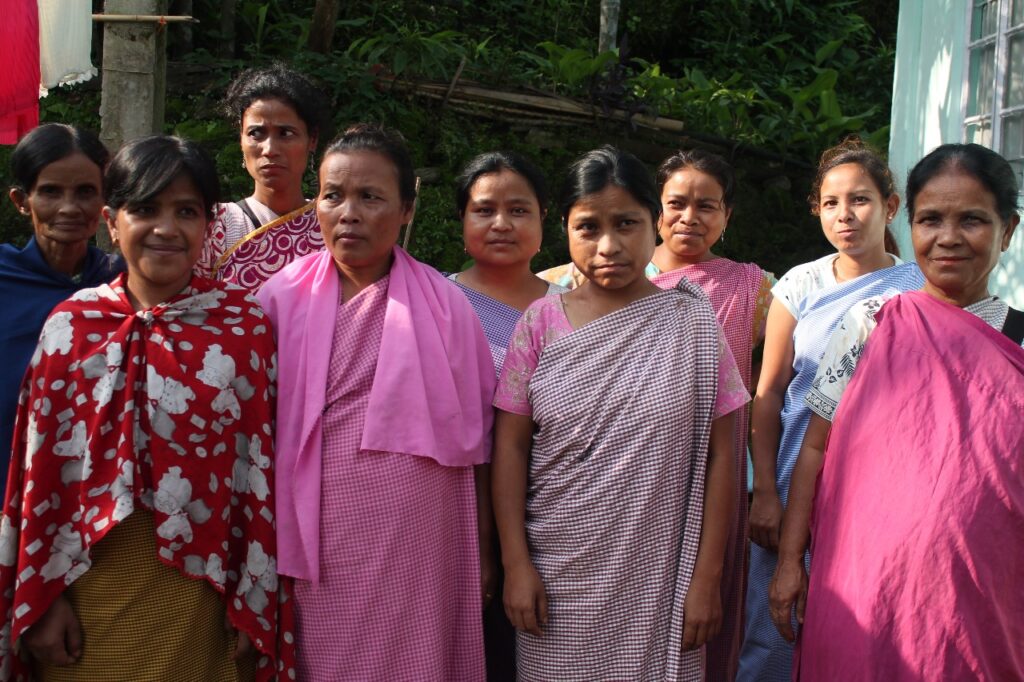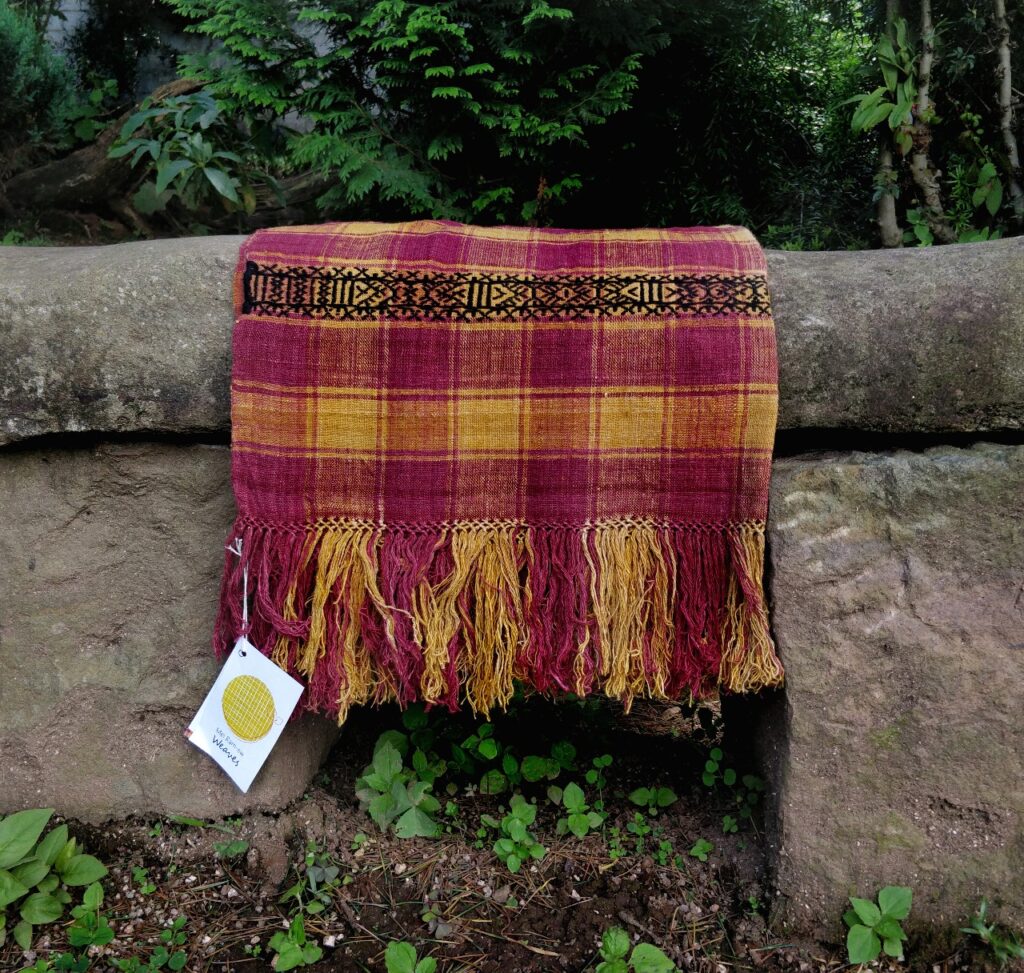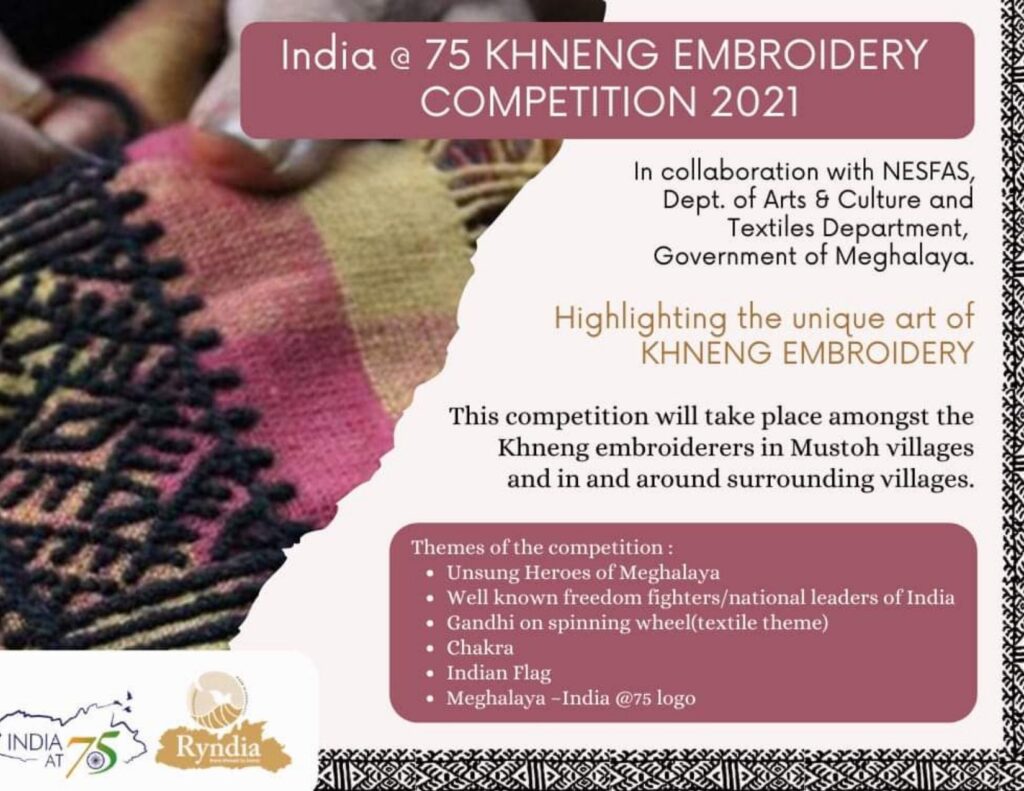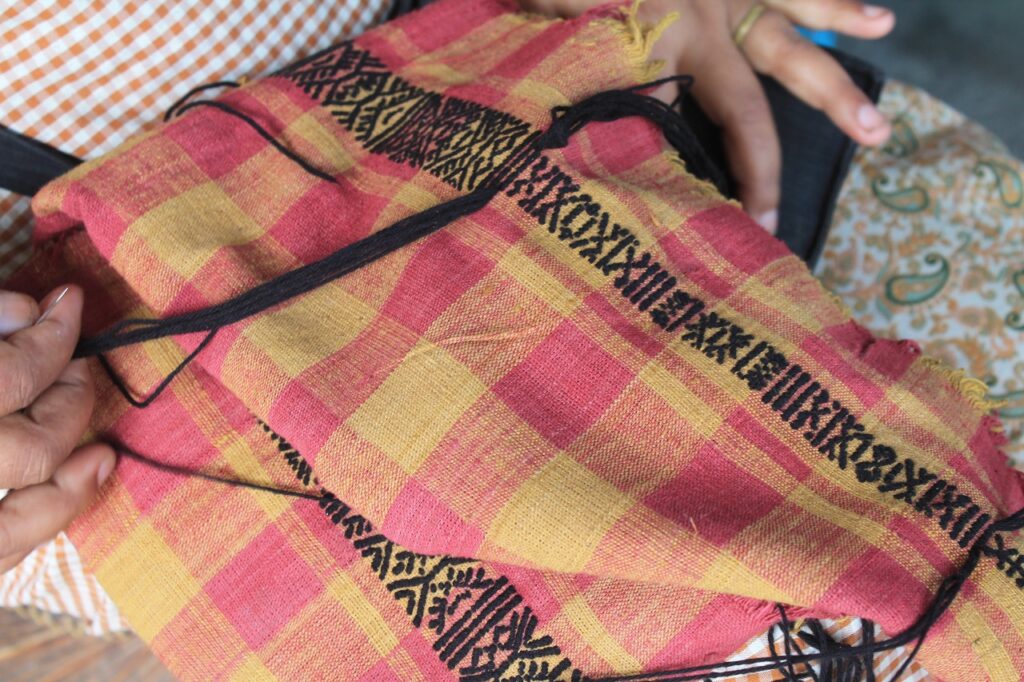Dept of Arts and Culture and the Dept of Textile, Govt of Meghalaya organises KHNENG EMBROIDERY COMPETITION 2021 in collaboration with NESFAS on India@75 Independence Day
Khneng embroidery is a 200 year-long tradition that is unique to Meghalaya and is also the only known traditional embroidery technique of the State. The word ‘Khneng’ roughly translates to ‘border’ in Khasi and the inspiration of the embroidery pattern is drawn from a local insect called ‘ktiar’ that resembles a centipede. A single line of thick band is stitched on one side of the jaiñpïen (wrap around) vertically. On a jaiñkup (shawl), a line of a thicker and a thinner band of Khneng embroidery is stitched horizontally. Two lines of embroidery are always stitched together on the shawl.
Until as recently as 2014, Khneng embroidery was a tradition that was slowly ebbing away in significance. The art of embroidering the borders of jaiñpïen and jaiñkup of the womenfolk from Mustoh and Shella was being phased out as the number of artisans dwindled. A headcount on the number of Khneng embroiderers in 2014 revealed a lowly figure of just 3 artisans from Mustoh who still possessed the skill of this unique embroidery technique.
NESFAS’ work with Communities to preserve and revive the art of Khneng
Alarmed by the dangers of the total disappearance of Khneng embroidery, the importance of preserving and reviving this unique art was brought forward by Bah Phrang Roy, Founding Chairperson of North East Slow Food & Agrobiodiversity Society, who originally hails from Mustoh. In 2014, NESFAS struck up a collaboration with the Special Purpose Vehicle Society (SPVS), and took the decision to jointly work together in reviving Khneng embroidery.
Following preliminary visits in December 2014, NESFAS initiated a workshop on the preservation of Khneng from the 28th January to 5th February 2015 with the help of a local consultant, Lajoplin Nongsiej and Anna-Louise Meynell, a consultant from Scotland who represented NESFAS. The workshop was facilitated by the three last knowledge holders of Khneng embroidery with 11 trainees attending to learn and take up the art. The first workshop was focused mainly on teaching the weaving techniques of simple patterns and the name of the various patterns to the trainees.
This was followed up by the second workshop in April 2016 among the same group of trainees with a focus on learning the advanced patterns following the analysis of old pieces. A third workshop was conducted on the possibilities of using natural fibres as the thread for the embroidery. It is believed that originally, a natural fibre made of grass was used to stitch the patterns. Unfortunately, over time, the knowledge of the thread used traditionally was lost which was replaced with acrylic wool. The workshop led to the conclusion that the best alternative is cotton when a comparison was drawn between cotton, Eri, and Muga silk thread.
In March 2021, another training was conducted in Mustoh on Khneng embroidery to strengthen and increase the number of people engaged in this art. A total of 10 trainees attended the workshop on the 2nd of March.
Celebrating the revival of Khneng Embroidery
Today, seven years later, after the intervention of NESFAS in reviving the practice of this unique art that was once on the verge of disappearing, Khneng embroidery is slowly making a comeback. Presently, there are 18 Khneng embroiderers, however, skilful artisans are on the rise every year with every workshop. Khneng embroidered Eri silk fabrics have also been sold in Farmers’ markets, conferences, hospitality sector and shows within the state and also all over India.
The work of NESFAS in reviving this art among the local communities hasn’t gone unnoticed at the government level, with fresh synergies and collaborations developing between NESFAS and the Dept of Textiles in particular. In a bid to promote Khneng embroidery and to celebrate and recognize the artisans who have kept this unique tradition alive, the Department of Arts and Culture and the Department of Textiles, Govt. of Meghalaya, in collaboration with NESFAS is all set to organize the “Khneng Embroidery Competition” to commemorate National Handloom day on August 7th, which is the day when Swadeshi Movement commenced, as an important milestone of the National Movement. The above programme is especially significant as it also highlights the indigenous and artistic tribal dexterity in weaves, as part of India@75 and Meghalaya@50 programmes in the country in general and Meghalaya in particular. A number of Khneng embroiderers are participating in the competition with the themes centred on the following categories:
- Unsung Heroes of Meghalaya
- Well known freedom fighters/national leaders of India
- Gandhi on spinning wheel(textile theme)
- Chakra
- Indian Flag
- Meghalaya –India @75 logo
The competition, which is set to be organised in an impactful manner will be a shot in the arm not only for focussed promotion but for highlighting the unique art of Khneng embroidery as well. Competitors have been given the freedom to showcase their embroidery skills in any form – stole, wall hanging, runners, masks, mufflers, clutches, laptop/tablet bag, pencil cases, tea coaster, wine coaster, napkin, etc. This competition also promises to enhance the visibility of the art and the artisans amongst an emerging and discerning audience.
Bah F. R. Kharkongor, Commissioner and Secretary, Dept. of Textiles, expressed his delight in partnering with NESFAS for the competition, and shared, “The joint initiative taken would contribute in widening, deepening, and expanding Khneng embroidery in the days to come ”.
He also remarked, “We are delighted to partner with NESFAS, in this the 75th year of our country’s Independence, which also coincides with the 50 years of our Statehood. We firmly believe that jointly, we can coalesce and synergize our efforts and resources to actively promote Khneng Embroidery, which is a 200-year-old unique art of our Border Villages, and it is only befitting that we now train the spotlight on this unique cultural legacy”.
A few initiatives taken by the Textiles Department
Earlier in the year, the Department of Textiles had declared the very First Eri Silk Village of Meghalaya in Raid Nongtluh-Umden-Diwon area, Ri-Bhoi District. Bah F.R Kharkongor informed that the department is very keen to jointly work with NESAFAS to promote Mustoh as the First Traditional Embroidery village of the state. Towards this objective, the Textiles department is also supporting the very first ‘Khneng Embroidery Competition’, for the practitioners of Khneng, with a hope that the competition and the prizes will further contribute towards greater recognition and encouragement for both the artisans and Khneng Embroidery itself.
“As Gandhiji said when he visited Sualkochi in Assam – the women here are weaving dreams, on their looms – perhaps, Khneng embroiderers will also embroider magic and dreams through their needles.” further expressed Bah F.R. Kharkongor.
The Textiles Dept. is also exploring the option of using the training unit at Saikarap near Shella, as a training center for Khneng embroidery to further promote proponents of Khneng. The Dept. has been in constant touch with the North East Handicrafts & Handlooms Corporation Ltd. (NEHHDC), who have recently tied up with Amazon to better and more effectively market Meghalaya’s Eri Products on e-commerce platforms, Bah F.R. Kharkongor hoped that the same can be done for Khneng, once Khneng embroidery products are available in sufficient quantity and also meet requisite quality standards
It has been NESFAS’ greatest honour to have worked with the knowledge holders and communities at various levels that have led to the revival of the Khneng embroidery tradition. The recognition from the Govt. and the Khneng Embroidery competition can be regarded as the culmination of all the activities that have been taken up under the umbrella of Mei-Ramew Weaves of NESFAS which is presently led by Janak Preet Singh, Senior Associate, Livelihood and Aurilia Tariang, Field Coordinator.
“Khneng embroidery has come a long way from a time when very few were aware of it to now being known by many. This, personally, has been a delightful journey and I believe, with due recognition, this unique Indigenous art form will add to the rich heritage of our state and our country as a whole.” expressed Janak Preet Singh.
With the mission to further enhance the livelihood activities of partner communities, NESFAS will continue to work, not only to strengthen but also revive and promote Khneng embroidery as well as other art forms under the Mei-Ramew Weaves banner.
 Translate
Translate








